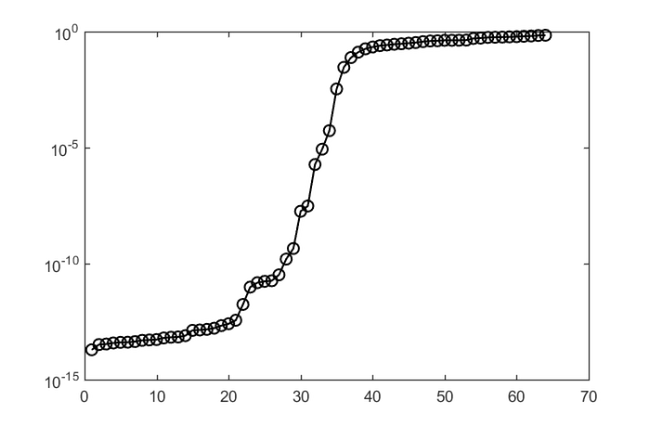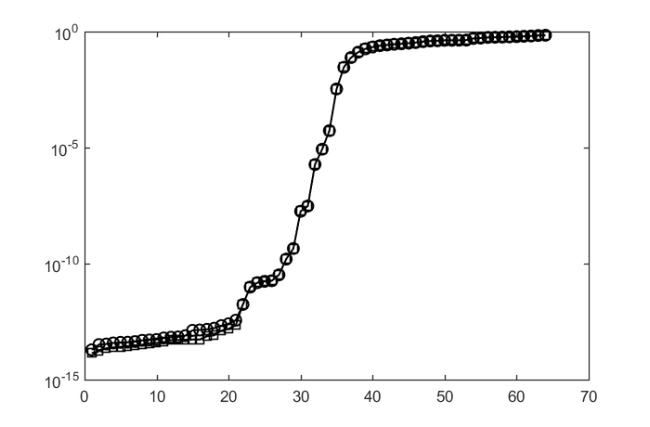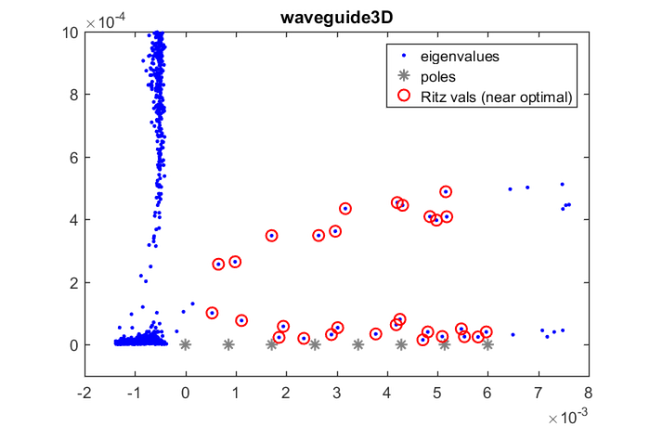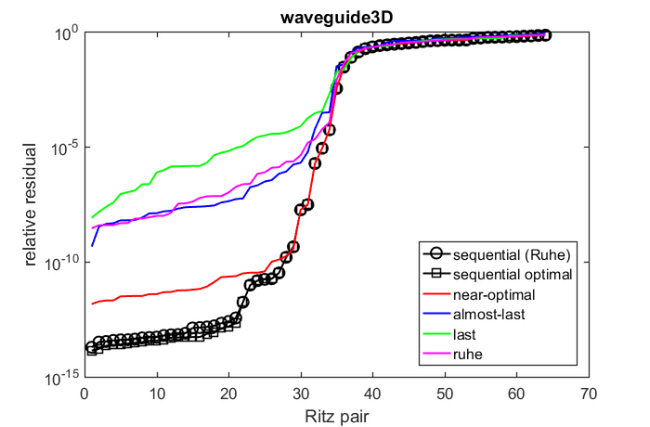Waveguide example
Mario Berljafa and Stefan Güttel, May 2016Download PDF or m-file
Contents
Introduction
This script reproduces the waveguide example from [1, Sec. 5.3], where a detailed discussion can be found.
MATLAB code
We first load the data, and a few of the "exact" eigenvalues of  (precomputed with MATLAB's eigs).
(precomputed with MATLAB's eigs).
if exist('waveguide3D.mat') ~= 2 disp('File waveguide3D.mat not found. Downloadable from:') disp(['http://www.cise.ufl.edu/research/sparse/' ... 'matrices/FEMLAB/waveguide3D.html']) return end N = 21036; load waveguide3D A = Problem.A; try, load waveguide3D_ee; catch, ee = []; end
Here's some further initialisation and a plot of the eigenvalues and poles we want to use in the rational Krlov method.
b = ones(N, 1); p = 8; rep = 8; shift = 3e-3; % harmonic target Xi = linspace(0, 6e-3, p); Xi = Xi([1, 5, 3, 6, 2, 7, 4, 8]); xi = repmat(Xi, 1, rep); m = length(xi); figure(1) plot(ee, 'b.'), hold on plot(real(Xi), imag(Xi), 'k*', 'Color', [0.5, 0.5, 0.5]) legend('eigenvalues', 'poles', 'Location', 'NorthEast') title('waveguide3D') axis([-2e-3, 8e-3, -1e-4, 1e-3])

disp(['Running Ruhe sequential strategy']) param = struct('continuation', 'ruhe', ... 'orth', 'MGS', ... 'reorth', 1, ... 'waitbar', 1); [V, K, H, out] = rat_krylov(A, b, xi, param); AV = A*V; S = AV; S = S-V*(V\S); s = svd(S); R = out.R; D = fminsearch(@(x) cond(R*diag(x)), ones(size(R, 2), 1), ... struct('Display','off')); nrm = norm(V'*V - eye(size(V,2))); fprintf(' Cond number (scaled): %.3e\n', cond(R*diag(D))) fprintf(' Orthogonality check: %.3e\n', nrm) fprintf(' sigma_2/sigma_1: %.3e\n\n', s(2)/s(1)) H = H - shift*K; [X,ritz] = eig(K'*H,K'*K); ritz = diag(ritz) + shift; X = V*K*X; [Res,ind] = sort(sqrt(sum(abs(A*X - X*diag(ritz)).^2))./ ... (sqrt(sum(abs(A*X).^2)) + ... sqrt(sum(abs(X*diag(ritz)).^2)))); figure(2), semilogy(Res,'k-o'), hold on
Running Ruhe sequential strategy Cond number (scaled): 1.578e+03 Orthogonality check: 7.330e-15 sigma_2/sigma_1: 1.868e-13

disp(['Running optimal sequential strategy']) param.continuation = 'near-optimal'; [V, K, H, out] = rat_krylov(A, b, xi, param); AV = A*V; S = AV; S = S-V*(V\S); s = svd(S); R = out.R; D = fminsearch(@(x) cond(R*diag(x)), ones(size(R, 2), 1), ... struct('Display','off')); nrm = norm(V'*V - eye(size(V,2))); fprintf(' Cond number (scaled): %.3e\n', cond(R*diag(D))) fprintf(' Orthogonality check: %.3e\n', nrm) fprintf(' sigma_2/sigma_1: %.3e\n\n', s(2)/s(1)) H = H - shift*K; [X,ritz] = eig(K'*H,K'*K); ritz = diag(ritz) + shift; X = V*K*X; [Res,ind] = sort(sqrt(sum(abs(A*X - X*diag(ritz)).^2))./ ... (sqrt(sum(abs(A*X).^2)) + ... sqrt(sum(abs(X*diag(ritz)).^2)))); figure(2), semilogy(Res,'k-s'), hold on
Running optimal sequential strategy Cond number (scaled): 1.070e+00 Orthogonality check: 7.329e-15 sigma_2/sigma_1: 8.870e-15

Parallel variants
Here we compare four different continuation strategies for the parallel rational Arnoldi simulating  cores.
cores.
strat = {'near-optimal', 'almost-last', 'last', 'ruhe'};
col = {'r', 'b', 'g', 'm'};
ucf = @(AB, nu, mu, x, param) ...
util_continuation_fom(AB, nu, mu, x, param);
p = 8;
param.p = p;
param.continuation_m = 5;
param.continuation_root = inf;
for s = 1:length(strat)
disp(['Running strategy ' strat{s}])
param.continuation = strat{s};
[V, K, H, out] = rat_krylov(A, b, xi, param);
AV = A*V; S = AV; S = S-V*(V\S); ss = svd(S); R = out.R;
D = fminsearch(@(x) cond(R*diag(x)), ones(size(R, 2), 1), ...
struct('Display','off'));
nrm = norm(V'*V - eye(size(V,2)));
fprintf(' Cond number (scaled): %.3e\n', cond(R*diag(D)))
fprintf(' Orthogonality check: %.3e\n', nrm)
fprintf(' sigma_2/sigma_1: %.3e\n\n', ss(2)/ss(1))
H = H - shift*K; [X,ritz] = eig(K'*H,K'*K);
ritz = diag(ritz) + shift; X = V*K*X;
Res = sort(sqrt(sum(abs(A*X - X*diag(ritz)).^2))./ ...
(sqrt(sum(abs(A*X).^2)) + ...
sqrt(sum(abs(X*diag(ritz)).^2))));
ritz = ritz(ind);
if s==1
ritz = ritz(Res < 1e-8);
figure(1), hold on
plot(real(ritz), imag(ritz), 'o', 'Color', col{s})
end
figure(2), semilogy(Res, 'Color', col{s}), hold on
end
figure(1), title('waveguide3D')
legend('eigenvalues', 'poles', 'Ritz vals (near optimal)')
figure(2), title('waveguide3D')
xlabel('Ritz pair'), ylabel('relative residual')
legend('sequential (Ruhe)', 'sequential optimal', ...
'near-optimal', 'almost-last', 'last', ...
'ruhe', 'Location', 'SouthEast')
Running strategy near-optimal Cond number (scaled): 2.103e+04 Orthogonality check: 7.330e-15 sigma_2/sigma_1: 7.514e-12 Running strategy almost-last Cond number (scaled): 5.619e+15 Orthogonality check: 7.331e-15 sigma_2/sigma_1: 9.587e-02 Running strategy last Cond number (scaled): 6.577e+08 Orthogonality check: 7.330e-15 sigma_2/sigma_1: 2.977e-08 Running strategy ruhe Cond number (scaled): 4.656e+08 Orthogonality check: 7.330e-15 sigma_2/sigma_1: 1.098e-08


Links to other examples
Here is a list of other numerical illustrations of parallelization strategies:
Overview of the parallelization options
Numerical illustration from [1, Sec. 3.4]
TEM example from [1, Sec. 5.1]
Inlet example from [1, Sec. 5.2]
References
[1] M. Berljafa and S. Güttel. Parallelization of the rational Arnoldi algorithm, SIAM J. Sci. Comput., 39(5):S197--S221, 2017.
[2] T. A. Davis and Y. Hu. The University of Florida Sparse Matrix Collection, ACM Trans. Math. Software, 38:1--25, 2011.